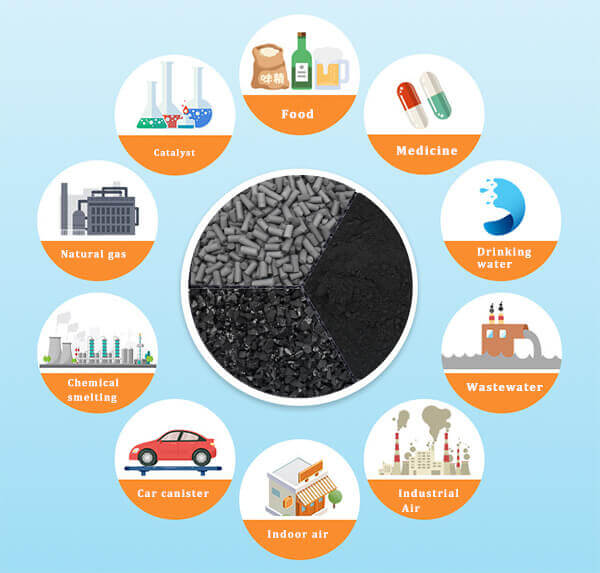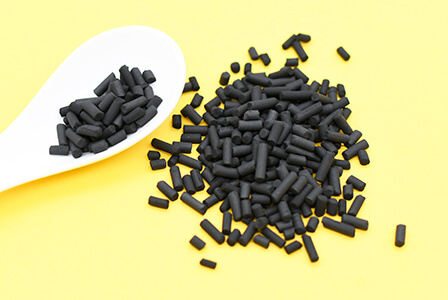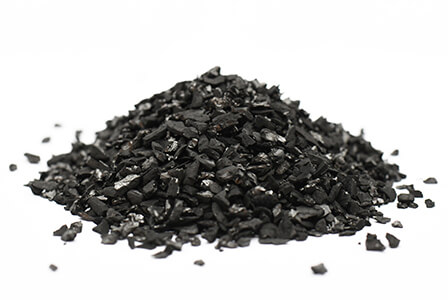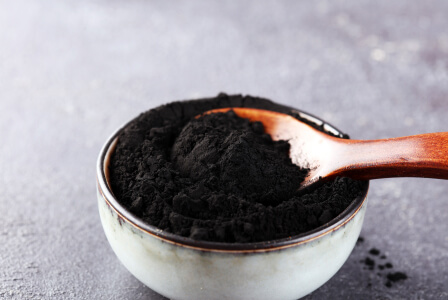
Wood pellet activated carbon
Wood columnar activated carbon is made of high-quality sawdust through crushing, mixing, extrusion, molding, drying, carbonization and activation. It is suitable for wide applications such as water purification, decolorization, solvent recovery, VOCs treatment, waste gas treatment, carrier catalysis, air purification, desulfurization, etc.Main advantages of wood based activated carbon:
• The service life of wood based extruded activated carbon is 4-5 times that of ordinary coal-based activated carbon.
• Wood pellets activated carbon has high adsorption and desorption properties, thus greatly improving the recovery rate of solvents.
• Wood columnar activated carbon is cost-effective and suitable for recycling organic gases in such places.
• Wood-based Activated Carbon Pellets has a high ignition point and is safe to use.

The following is the detailed application introduction of wood activated carbon pellet:
Wood based columnar activated carbon for PSA
• Separating nitrogen and carbon dioxide from the air,• Separating methane from fermentation gas
• Separating hydrogen from methanol decomposition gas and blast furnace gas, etc.
| Model | Moisture(%) | Hardness(%) | Ash (%) | Iodine (%) | CTC (%) | Bulk density (g/l) |
Size (mm) |
| PSA-3080 | ≤3 | ≥98 | ≤7 | ≥1100 | ≥80 | 360±20 | Φ3.0 |
| PSA-3060 | ≤3 | ≥98 | ≤7 | ≥1000 | ≥60 | 380±20 | Φ3.0 |
| PSA-2580 | ≤3 | ≥95 | ≤7 | ≥1100 | ≥80 | 360±20 | Φ2.0 |
| PSA-2560 | ≤3 | ≥98 | ≤7 | ≥1000 | ≥60 | 380±20 | Φ2.0 |
Wooden columnar activated carbon for gas purification
Purification, separation and refinement• chemical raw material gases,
• chemical synthesis gases,
• pharmaceutical industry gases,
• carbon dioxide gas for beverages,
• hydrogen, nitrogen, hydrogen chloride,
• ethylene, ethane, cracked gas, inert gases, etc.
• exhaust gases from atomic facilities.
| Model | Moisture(%) | Hardness(%) | Ash (%) | Iodine (%) | CTC (%) | Bulk density (g/l) |
Size(mm) |
| AS-3090 | ≤5 | ≥98 | ≤7 | ≥1000 | ≥90 | 380±20 | Φ3.0 |
| AS-30100 | ≤5 | ≥95 | ≤7 | ≥1100 | ≥100 | 350±20 | Φ3.0 |
| AS-4090 | ≤5 | ≥98 | ≤7 | ≥1000 | ≥90 | 380±20 | Φ4.0 |
| AS-40100 | ≤5 | ≥95 | ≤7 | ≥1100 | ≥100 | 350±20 | Φ4.0 |
Ultra-low ash wood columnar activated carbon
It is suitable for purification and deodorization of drinking water; decolorization and refining of brewing industry, catalysts and carriers, medicines and chemicals, etc.| Model | Moisture(%) | Hardness(%) | Ash (%) | Iodine (%) | methylene blue Value (mg/g) |
Bulk density (g/l) |
PH | Size (mm) |
| WCA-4090 | ≤5 | ≥90 | ≤2 | ≥1000 | ≥180 | 380±20 | 5-7 | Φ4.0 |
| WCA-40100 | ≤5 | ≥90 | ≤2 | ≥1100 | ≥200 | 350±20 | 5-7 | Φ4.0 |
| WCA-3090 | ≤5 | ≥98 | ≤2 | ≥1000 | ≥180 | 380±20 | 5-7 | Φ3.0 |
| WCA-30100 | ≤5 | ≥95 | ≤2 | ≥1100 | ≥200 | 350±20 | 5-7 | Φ3.0 |
Wooden columnar activated carbon for catalysts and carriers
It is mainly used for the treatment of toxic or odorous industrial waste gases containing hydrogen sulfide, methyl mercaptan, sulfur dioxide, methyl sulfide, dimethyl sulfide, mercury vapor, ammonia, etc.| Model | Moisture(%) | Hardness(%) | H2S (g/cc) | CTC(%) | Bulk density (g/l) |
Size(mm) |
| WCC-3070 | ≤5 | ≥98 | ≥0.15 | ≥70 | 400±20 | Φ3.0 |
| WCC-3080 | ≤5 | ≥98 | ≥0.15 | ≥80 | 380±20 | Φ3.0 |
| WCC-4070 | ≤5 | ≥98 | ≥0.15 | ≥70 | 400±20 | Φ4.0 |
| WCC-4080 | ≤5 | ≥98 | ≥0.15 | ≥80 | 380±20 | Φ4.0 |
Wooden columnar activated carbon for solvent recovery
Strong separation and recovery properties for organic solvents and vapours:• ethers, ketones, alcohols, tetrahydrofuran
• dichloromethane, chloroform, trichlorethylene
• perchlorethylene, carbon disulfide, benzene, toluene
• formyl, gasoline, fluorinated hydrocarbons, etc.
| Model | Moisture(%) | Hardness(%) | Ash(%) | Benzene adsorption(%) |
CTC (mg/g) |
Bulk density(g/l) |
Ignition point(℃) |
Size (mm) |
| WCS-3080 | ≤5 | ≥95 | ≤7 | ≥35 | ≥80 | 400±20 | 380±30 | Φ3.0 |
| WCS-3090 | ≤5 | ≥90 | ≤7 | ≥40 | ≥90 | 380±20 | 380±30 | Φ3.0 |
| WCS-30100 | ≤5 | ≥90 | ≤8 | ≥45 | ≥100 | 350±20 | 380±30 | Φ3.0 |
| WCS-4080 | ≤5 | ≥98 | ≤7 | ≥35 | ≥80 | 400±20 | 380±30 | Φ4.0 |
| WCS-4090 | ≤5 | ≥98 | ≤7 | ≥40 | ≥90 | 380±20 | 380±30 | Φ4.0 |
| WCS-40100 | ≤5 | ≥95 | ≤8 | ≥45 | ≥100 | 350±20 | 380±30 | Φ4.0 |
Wood Granular Activated Carbon
Wood granular activated carbon, also known as wood GAC, is a highly porous and adsorbent material derived from wood-based sources such as coconut shells, nutshells, and sawdust. It undergoes a process called activation to create a network of small pores, increasing its surface area and enhancing its ability to adsorb impurities and contaminants. Wood GAC is widely used in various applications such as water and air purification, gas treatment, and removal of organic compounds and odors. Its natural composition and renewable source make it an environmentally friendly choice for effective filtration and purification processes.
The following is the application and parameters of wood granular activated carbons:
• organic solvent recovery;
• oil and gas recovery;
• air purification;
• water treatment;
• deodorization;
• military anti-toxic carbon for filling various filters gas masks
• carrier of desiccant in mine filter self-rescuers, poison filtration and ventilation devices;
• brewing industry, Catalysts and carriers,
• decolorization and refining of pharmaceuticals and chemicals, etc.
| Model | Moisture(%) | Hardness(%) | Ash(%) | Iodine (%) | CTC (mg/g) |
Bulk density(g/l) |
BWC (g/100ml) |
Mesh |
| ZLC-6*8 | ≤5 | ≥70 | ≤6 | ≥1000 | ≥100 | 340±20 | ≥10 | 6×8 |
| ZLC-6*16 | ≤5 | ≥60 | ≤6 | ≥1000 | ≥100 | 340±20 | - | 6×16 |
| ZLC-8*30 | ≤5 | ≥50 | ≤6 | ≥1000 | ≥100 | 340±20 | - | 8×30 |
| ZLC-20*40 | ≤5 | ≥50 | ≤6 | ≥1000 | ≥100 | 340±20 | ≥11 | 20×40 |
| ZLC-20*50 | ≤5 | ≥50 | ≤6 | ≥1000 | ≥100 | 340±20 | ≥11 | 20×50 |
| ZLC-40*80 | ≤5 | ≥50 | ≤6 | ≥1000 | ≥100 | 340±20 | ≥11 | 40×80 |
Wood Powder Activated Carbon
wood based powdered activated carbon is refined from fruit shells and sawdust as raw materials. It looks like a fine black powder. And It is non-toxic and tasteless. Wood-based powdered activated carbon has a large specific surface area and strong adsorption capacity, which is suitable for colour removal in sugar refining, pharmaceuticals, beverages, alcohol, etc. In the water purification industry, it is also widely used in the decolorization, refining, purification and sewage treatment of organic solvents.
The production methods of wood activated carbon powder are divided into two types: phosphoric acid production and zinc chloride production.
• Wood powder activated carbon produced by the phosphoric acid method has the characteristics of developed mesopore structure and developed specific surface area, large adsorption capacity, fast filtration speed, and does not contain zinc salts.
It is widely used in the decolorization and refining of sugar, glutamic acid and salt, lactic acid and salt, citric acid and salt, wine, condiments, animal and plant proteins, biochemical products, pharmaceutical intermediates, vitamins, antibiotics and other products in the food industry.

• Wooden powdered activated carbon produced by the zinc chloride method has the characteristics of a developed mesoporous structure, large adsorption capacity, and rapid filtration.
It is mainly suitable for decolorization, purification and deodorization of high pigment solutions such as various amino acid industries, refined sugar decolorization, MSG industry, glucose industry, starch sugar industry, chemical additives, dye intermediates, food additives, pharmaceutical preparations.
Because these processes make the mesoporous structure and specific surface area of wooden activated carbon more developed, it has many advantages:
• large adsorption capacity
• fast filtration speed
• high strength
• low ash content
• reasonable pore size distribution
The following is the wood powder activated carbon parameters:
| Item | Index | |
| A | B | |
| Iodine, mg/g ≥ | 1000 | 900 |
| Methylene blue adsorption rate,ml/0.1g mg/g ≥ | 9.0 (135) |
7.0 (105) |
| Hardness,% g/ml ≥ | 94.0 | 85.0 |
| Apparent density, g/ml | 0.45-0.55 | 0.32-.47 |
| Moisture,% ≤ | 10.0 | 10.0 |
| PH,% ≥ | 5.5-6.5 | 5.5-6.5 |
| Ash,% ≤ | 5.0 | 5.0 |
Main factors affecting activated carbon adsorption:
• The properties of the activated carbon adsorbent, the larger its surface area, the stronger the adsorption capacity; the size of the activated carbon adsorbent particles, the structure of the pores and distribution and surface chemical properties also have a great impact.• The nature of the adsorbate depends on its solubility, surface free energy, polarity, size and unsaturation of the adsorbate molecules, concentration of the adsorbent, etc.
• Based on the pH value of liquid, activated carbon generally has a higher adsorption rate in acidic solutions than in alkaline solutions. The pH value will affect the existence state and solubility of the adsorbate in water, thereby affecting the adsorption effect.
• Temperature has little effect on the adsorption of activated carbon.
• There should be a certain contact time between the activated carbon and the adsorbent, so that the adsorption is close to equilibrium and the adsorption capacity is fully utilized.

